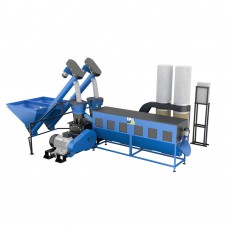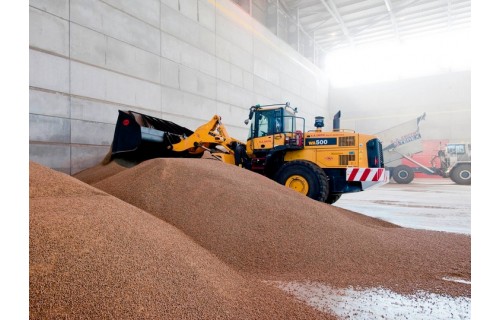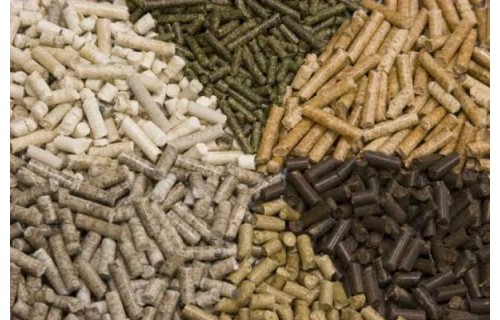Rentabilität bei der Herstellung von Sägemehl-Pellets

Angenommen, Sie betreiben eine Tischlerei, Sie haben trockene Holzabfälle, aus denen Pellets hergestellt werden können, dh der Rohstoff für die Herstellung von Pellets ist kostenlos.
Der durchschnittliche Energiepreis nach dem Tarif G11 beträgt 0,5118 PLN netto pro 1 kW. Dieser Preis besteht aus:
- Variable / Netzwerkverteilungsgebühr
- Feste Vertriebs-/Übermittlungsgebühr
- Übergangsgebühr
- Abonnementgebühren
- KWK-Gebühr rund um die Uhr
- Res-Gebühr rund um die Uhr
- Stromladung
- Qualitätsgebühr

Source - https://globenergia.pl/ile-kosztuje-1-kwh-energii-elektrycznej-z-czego-sklada-sie-rachunek/
Die Berechnung wird am Beispiel der Arbeiten an der LDG-3000 KOMBI-Linie durchgeführt, die Folgendes umfasst:
1. Schneckenförderer PS-200:
2. Befeuchtungssystem:
3. PRIME - 300:
4. Kalibrator-Kühler für KC-100 Granulate / Pellets:
5. Geschlossene Abgasanlage SO-2:
6. Systemsteuerung:
Gesamtstromverbrauch der Leitung-25 kW pro Stunde.
Auf der KOMBI-Linie LDG - 3000 mit einer Pelletmühle mit Walzen eines neuen Typs können etwa 400 kg Pellet pro Stunde hergestellt werden. Eine schnelle Berechnung zeigt, dass es in 8 Stunden möglich ist, 3.200 kg Pellet oder 64.000 kg Pellet pro Monat zu produzieren.
Wir gehen davon aus, dass das Durchschnittsgehalt eines Mitarbeiters in der Pelletproduktionslinie 2.600 PLN netto beträgt. Dies bedeutet, dass der Arbeitnehmer für eine Arbeitsstunde ein Nettogehalt von 16 PLN erhält.
Der Preis der Matrix für Pellet Pellet prime-300 für Kiefernsägemehl-1250 PLN netto für 1 Stück. Die Lebensdauer der Matrix-bis zu 70 Tonnen. Es kann berechnet werden, dass die Kosten für die Matrixabschreibung für die Herstellung von 1 kg Pellet 0,0179 PLN netto betragen (1250 PLN / 70000 kg = 0,0179).
Auf die gleiche Weise berechnen wir die Abschreibungskosten von Wälz- und Lagerschalen. Die Kosten für einen Lagersatz für die Pelletpresse PRIME-300-480 PLN netto und die Lebensdauer betragen bis zu 40 Tonnen. Die Lagerabschreibung für die Herstellung von 1 kg Pellet beträgt 0,012 PLN netto.
Satz Mäntel für Walzen-928 PLN netto. Die Abschreibung von Mänteln für die Herstellung von 1 kg Pellets beträgt 0,0077 PLN.
Basierend auf den obigen Daten können Sie die Kosten für die Pelletproduktion abschätzen:
25 kW (Linie) * 0,5118 (Nettokosten von 1 kW) * 8 (Betriebsstunden der Maschine) + 128 PLN (Gehalt des Mitarbeiters für 8 Arbeitsstunden) + 3200*(0,0179+0,0077+0,012) = 352,65 – die täglichen Produktionskosten von 3200 kg Pellet, dh die Produktion von 1 Tonne Pellet, kosten 110,2 PLN netto.
Production of pellets from dry sawdust, free of charge. 25 kW line |
||
|
Price 1 kW (net) |
0,5118 |
zł |
|
Line power consumption |
25 |
kW |
|
Number of employees on the line |
1 |
osoba |
|
Average monthly salary in this position (net) |
2 600 |
zł |
|
Number of hours at work |
8 |
h |
|
Employee's net salary, h |
16 |
zł |
|
1 h line capacity on new type rollers |
400,00 |
kg/h |
|
Daily Line Capacity (8 hours of line operation) |
3 200 |
kg |
|
Matrix life in kg |
70 000 |
kg |
|
Matrix price (net) |
1 250 |
zł |
|
Matrix depreciation for 1kg production (net) |
0,0179 |
zł |
|
Matrix depreciation, h (net) |
7,143 |
zł |
|
Roll life in kg |
120 000 |
kg |
|
Price of set of roller coats (net) |
928 |
zł |
|
Shock absorption coat for production 1kg (net) |
0,0077 |
zł |
|
Depreciation of coats, h (net) |
3,093 |
zł |
|
Bearing life in kg |
40 000 |
kg |
|
Bearing set price (net) |
480 |
zł |
|
Bearing depreciation for 1kg production (net) |
0,012 |
zł |
|
Bearing depreciation, h (net) |
4,80 |
zł |
|
Electricity price, h |
12,795 |
zł |
|
The cost of bags (67 PCs.), tapes for 1T pellet |
21,15 |
zł |
|
pallet cost per 1t pellet |
18,00 |
zł |
|
Number of working days (average per year) |
253,00 |
dni |
|
Pellet production cost, per day (3200 kg) |
352,65 |
zł |
|
Net cost of Production 1000 kg pellet, without packaging |
110,20 |
zł |
|
Net cost of production of 1000 kg pellet, packed |
149,35 |
zł |
|
Average annual price of 1000 kg pellet on the market, net |
700,00 |
zł |
|
Potential net profit / t (net) |
550,65 |
zł |
|
Potential net profit / per day (net) |
1 762,07 |
zł |
|
Potential net profit / year (net) |
445 803,83 |
zł |
Rentabilität der Pelletproduktion aus nassem Sägemehl
Auf ähnliche Weise können Sie einen Kostenvoranschlag für Sägewerke erstellen, die nasses Sägemehl haben. Natürlich ist es unmöglich, Pellets aus nassem Sägemehl herzustellen. Hierzu kommt eine zusätzliche Maschine ins Spiel, nämlich ein aerodynamischer Sägemehltrockner SA-400 mit einer Leistungsaufnahme von 5 kW. Darüber hinaus müssen Sie zur Berechnung des Gehalts des zweiten Mitarbeiters in Höhe von 2600 PLN netto hinzufügen, der am Trockner arbeiten wird.
30 kW (Linie + Trockner) * 0,5118 (Nettokosten von 1 kW) * 8 (Betriebsstunden der Maschine) + 256 PLN (Gehalt von zwei Mitarbeitern für 8 Arbeitsstunden) + 3200*(0,0179+0,0077+0,012) = 499,12 PLN netto-die täglichen Produktionskosten von 3200 kg Pellet, dh die Produktion von 1 Tonne Pellet kostet 155,98 PLN netto.
|
Production of pellets from wet sawdust, free of charge. 30 kW line |
||
|
Price 1 kW (net) |
0,5118 |
zł |
|
Line power consumption |
30 |
kW |
|
Number of employees on the line |
2 |
osoby |
|
Average monthly salary in this position (net) |
2 600 |
zł |
|
Number of hours at work |
8 |
h |
|
Net remuneration of two employees, h |
32 |
zł |
|
1 h line capacity on new type rollers |
400,00 |
kg/h |
|
Daily Line Capacity (8 hours of line operation) |
3200 |
kg |
|
Matrix life in kg |
70 000 |
kg |
|
Matrix price (net) |
1 250 |
zł |
|
Matrix depreciation for 1kg production (net) |
0,0179 |
zł |
|
Matrix depreciation, h (net) |
7,143 |
zł |
|
Roll life in kg |
120 000 |
kg |
|
Price of set of roller coats (net) |
928 |
zł |
|
Depriciation coat for production 1kg (net) |
0,0077 |
zł |
|
Depreciation of coats, h (net) |
3,093 |
zł |
|
Bearing life in kg |
40 000 |
kg |
|
Bearing set price (net) |
480 |
zł |
|
Bearing depreciation for 1kg production (net) |
0,012 |
zł |
|
Bearing depreciation, h (net) |
4,80 |
zł |
|
Electricity price, h |
15,354 |
zł |
|
The cost of bags (67 PCs.), tapes for 1T pellet |
21,15 |
zł |
|
pallet cost per 1t pellet |
18,00 |
zł |
|
Number of working days (average per year) |
253,00 |
dni |
|
Pellet production cost, per day (3200 kg) |
499,12 |
zł |
|
Net cost of Production 1000 kg pellet, without packaging |
155,98 |
zł |
|
Net cost of production of 1000 kg pellet, packed |
195,13 |
zł |
|
Average annual price of 1000 kg pellet on the market, net |
700,00 |
zł |
|
Potential net profit / t (net) |
504,87 |
zł |
|
Potential net profit / per day (net) |
1 615,60 |
zł |
|
Potential net profit / year (net) |
408 746,41 |
zł |
Rentabilität der Pelletproduktion beim Kauf von trockenem Sägemehl
Nicht jeder hat Zugang zu kostenlosem Sägemehl. Dafür ist es unsere Mission, nicht nur einen Kostenvoranschlag auf der Grundlage von freiem Rohstoff für die Herstellung von Pellets zu erstellen, sondern auch beim Kauf von Sägemehl für die Herstellung von Brennstoffpellets. Durchschnittspreis von 1mp pro olx.pl es ist 30 PLN netto.

Źródło – https://www.olx.pl/
Sie können auch Angebote mit geringerem Wert für Sägemehl oder sogar kostenlos finden.

Źródło – https://www.olx.pl/
Für die Herstellung von 1000 kg Pellets müssen Sie durchschnittlich 6mp Sägemehl verbrauchen. 19,2 mp Sägemehl-dies ist für die tägliche Produktion von 3200 kg Pellets erforderlich. Unsere Berechnung lautet also wie folgt:
25 kW (Linie) * 0,5118 (Nettokosten von 1 kW) * 8 (Betriebsstunden der Maschine) + 128 PLN (Gehalt des Mitarbeiters für 8 Arbeitsstunden) + 3200*(0,0179+0,0077+0,012) + 576 PLN netto (19,2 mp Sägemehl) = 928,65 PLN netto -die täglichen Produktionskosten von 3200 kg Pellet, dh die Produktion von 1 Tonne Pellet kostet 290,20 PLN netto.
|
Pellet production when buying dry sawdust. 25 kW line |
||
|
Price 1 kW (net) |
0,5118 |
zł |
|
Line power consumption |
25 |
kW |
|
Average net price of 1MP dry sawdust |
30 |
zł |
|
Number of employees on the line |
1 |
osoba |
|
Average monthly salary in this position (net) |
2 600 |
zł |
|
Number of hours at work |
8 |
h |
|
Employee's net salary, h |
16 |
zł |
|
1 h line capacity on new type rollers |
400,00 |
kg/h |
|
Daily Line Capacity (8 hours of line operation) |
3200 |
kg |
|
The necessary amount of mp sawdust for daily pellet production |
19,2 |
mp |
|
Valuable net for the necessary amount of mp sawdust for daily pellet production |
576,0 |
zł |
Matrix life in kg |
70 000 |
kg |
|
Matrix price (net) |
1 250 |
zł |
|
Matrix depreciation for 1kg production (net) |
0,0179 |
zł |
|
Matrix depreciation, h (net) |
7,143 |
zł |
|
Roll life in kg |
120 000 |
kg |
|
Price of set of roller coats (net) |
928 |
zł |
|
Shock absorption coat for production 1kg (net) |
0,0077 |
zł |
|
Depreciation of coats, h (net) |
3,093 |
zł |
|
Bearing life in kg |
40 000 |
kg |
|
Bearing set price (net) |
480 |
zł |
|
Bearing depreciation for 1kg production (net) |
0,012 |
zł |
|
Bearing depreciation, h (net) |
4,80 |
zł |
|
Electricity price, h |
12,795 |
zł |
|
The cost of bags (67 PCs.), tapes for 1T pellet |
21,15 |
zł |
|
pallet cost per 1t pellet |
18,00 |
zł |
|
Number of working days (average per year) |
253,00 |
dni |
|
Pellet production cost, per day (3200 kg) |
928,65 |
zł |
|
Net cost of Production 1000 kg pellet, without packaging |
290,20 |
zł |
|
Net cost of production of 1000 kg pellet, packed |
329,35 |
zł |
|
Average annual price of 1000 kg pellet on the market, net |
700,00 |
zł |
|
Potential net profit / t (net) |
370,65 |
zł |
|
Potential net profit / per day (net) |
1 186,07 |
zł |
|
Potential net profit / year (net) |
300 075,83 |
zł |
Zusammenfassung
In unserer Annahme ist ein großer Kostenfaktor das Gehalt des Mitarbeiters, was wiederum zu höheren Produktionskosten führt. Natürlich können Sie je nach Region und Ort einen Mitarbeiter finden, der weniger Geld verlangt, aber selbst mit einem solchen Gehalt ist die Pelletproduktion eine recht rentable Tätigkeit, da der durchschnittliche Marktpreis von 1 Tonne High-End-Pellet bei 700 PLN netto liegt. In den Berechnungen werden auch mögliche Ausfallzeiten, Steuern, Transportkosten und die Kosten für die Anmietung eines Zimmers nicht berücksichtigt. Natürlich können wir nicht alle Faktoren berücksichtigen, die mit der Herstellung von Pellets zusammenhängen, aber die obigen Listen ermöglichen es uns, die mit der Produktion verbundenen Kosten vollständig abzuschätzen.
Es lohnt sich also, heute in Pelletproduktionslinien zu investieren, bis in dieser Branche ein starker Wettbewerb herrscht!
Die Nachfrage nach Pellets steigt täglich. Dies hängt nicht nur mit dem Kofinanzierungsprogramm für den Austausch von Heizkesseln im Rahmen des Projekts "Saubere Luft" zusammen, sondern auch mit der globalen Besorgnis über den Klimawandel. Natürlich wird heute nicht nur Sägemehl für die Pelletsherstellung verwendet, sondern auch Stroh, Heu, Zuckerrohr, Miscant usw. Weitere Videos und Informationen finden Sie auf unserer YouTube-Seite: https://www.youtube.com/c/TechnoMaszBud/videos







